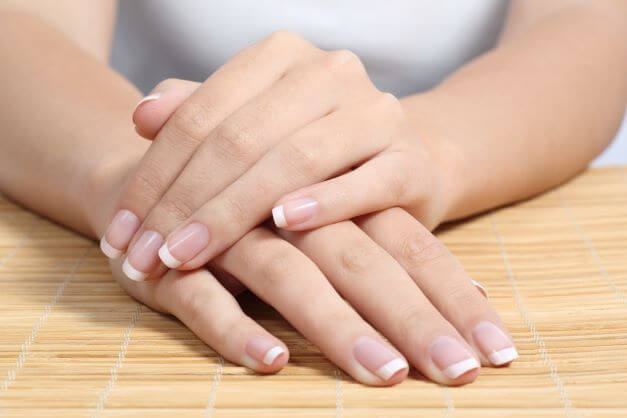When you hear nails, you may not immediately associate that with a trip to the dermatologist, but actually, your dermatologist is often the right specialist to help you address concerns related to nail health. According to Dr. Kathryn “Celeste” Durham of U.S. Dermatology Partners South Hulen in Fort Worth, Texas, “In addition to skincare, dermatology training also includes specialty education in hair and nail health. If you’ve noticed changes in the color, shape, or texture of your nails, you may be dealing with an issue that is just nail-deep. However, changes in nail health are also common warning signs of whole-body health concerns.” In this blog, Dr. Durham talks through some of the common warning signs of health conditions that present as changes in the appearance and health of nails.
What Healthy Nails Should Look Like
Everyone’s nails look a little different, but in general, healthy nails should be smooth and shiny without pits or grooves on the surface. They should be uniform in color apart from the lunula. This word literally translates to little moon, and it’s the word used to describe the half-moon-shaped part of the nail directly above the cuticle that is slightly lighter in color. Nails should be attached to the cuticle, but there shouldn’t be areas where nails have become ingrown. This means the nail is growing too deeply into the cuticles. Nails should be thick and strong, but they shouldn’t be so thick they feel inflexible or petrified. As we age, there are a number of normal age-related nail changes you may see including nails that grow more slowly, become thicker or more opaque, or have longitudinal ridging. Nicking or breakage of the nails may also happen more frequently with age as nails become more brittle. Your dermatologist can guide you on what changes are normal. Finally, nails are very absorbent, even more so than the skin, so keeping them moisturized is an important component of keeping nails healthy.
Nail Health Warning Signs
According to Dr. Durham, “If you notice any changes in the appearance or texture of your nails, it can be a sign that you’re in need of treatment. In most cases, the issue only impacts your nails and doesn’t indicate anything more serious. However, some changes in your nails may indicate a need for medical intervention. In these cases, your dermatologist may refer you to another physician to address related health issues. For nail changes that can be addressed through oral or topical medications, we can usually provide treatment.” Some common changes that don’t necessarily point to a need for more advanced treatment include:
- Spots of color or overall nail discoloration – This has numerous underlying causes, but discoloration is usually treatable by a dermatologist. Fungal infection is one of the most common issues that cause nail discoloration.
- Nail bed separation – In most cases, this is indicative of things like dehydration or damage to the nail bed or cuticle, and it doesn’t usually indicate any serious health concerns.
- Changes in shape – This is rare. Usually, changes in the shape of the tips of the nail don’t indicate anything serious, but changes in the shape of the lower part of the nails may be more concerning.
- Changes in nail thickness – Nails become thicker or thinner in response to a variety of changes in our health. Typically, this can be addressed by your dermatologist. In rare cases, it may be indicative of a whole-body health concern.
When to See a Dermatologist for Nail Changes
While many changes in nail health aren’t indicative of a medical condition, Dr. Durham recommends, “Visit your dermatologist if you notice signs of change to your nails, cuticles, and nail beds, especially if these changes don’t improve or resolve within a week or two. This is especially true if there is no clear reason for the change like an injury, change in diet, new medication, or other underlying issues. It’s also important to reach out to a dermatologist if you experience any discomfort, swelling, pain, itching, or warmth around the affected nails.”
Medical Conditions Indicated by Changes in Nail Health
Numerous nail health changes can indicate underlying medical conditions. We’ll explore some of them below, but as Dr. Durham says, “It’s always better to have your nails examined by a professional, so you can receive an accurate diagnosis and any necessary treatments and physician referrals.”
- Beau’s Lines – These are ridges or indentations along the surface of the nail. They may be a symptom of diabetes, vascular disease, measles, mumps, and pneumonia.
- Brittle nails – Easily broken or split nails may be associated with exposure to too much moisture like excessive hand washing. Brittle nails are also more common for older adults. However, it can also be a sign of health conditions like Raynaud’s syndrome, hypothyroidism, and anemia.
- Clubbed Nails – The fingertips are enlarged and the nails curl over them. This may be a symptom of chronic obstructive pulmonary disease (COPD), inflammatory bowel disease (IBS), congestive heart failure, and cirrhosis. It’s also a sign of a lack of oxygen, which can be caused by lung disease.
- Koilonychia – This is a condition that causes the nails to soften and look like there are dips or scoops taken out of them. They are often referred to as spoon nails. This may be a symptom of iron deficiency anemia, hypothyroidism, and heart disease.
- Leukonychia – This is a common condition that causes nails to turn white or for white spots and lines to develop on the nails. Typically, this occurs due to mild damage like scraping the surface of nails during a manicure. However, it is also a warning sign of cirrhosis of the liver.
- Lindsay’s Nails – This condition occurs when a large percentage of the nail is covered in stripes of color. These stripes may be pink, brown, or red. It is a common symptom of kidney disease.
- Mees’ Lines – With this condition, thin pale or white-colored lines are across nails, running horizontally. It may impact more than one nail. Mees’ lines can be a symptom of arsenic poisoning, Hodgkin lymphoma, shingles, malaria, pneumonia, and renal failure. It is also associated with taking certain chemotherapy drugs.
- Muehrcke’s Nails – Characterized by pairs of white lines that run horizontally over the fingernails. This may be linked to malnutrition, protein deficiency, and liver disease.
- Onycholysis – The nail becomes partially detached from the nail bed so that it can be lifted up. It may be caused by trauma, but it’s also a symptom of skin infection, psoriasis, or nail psoriasis.
- Onychomadesis – The nail stops growing, which causes it to separate from the nail bed. This often happens to young children who are recovering from hand, foot, and mouth disease. It’s also a symptom of psoriasis and immune disease.
- Pitting – This appears as small depressions in the nail like a pin has poked a hole. These depressions can be just on the surface or go deeper into the nail. It’s a common side effect of psoriasis, eczema, and autoimmune diseases.
- Splinter hemorrhage – This appears as brown and red vertical stripes in the nail bed and takes its name from the way it looks like splinters stuck beneath the nails. In actuality, this condition is caused by blood under the nails. Splinter hemorrhage can occur as a symptom of endocarditis and heart disease.
- Terry’s Nails – A condition that causes nails to turn almost entirely white with red or pink stripes at the top. Terry’s Nails are a warning sign of cirrhosis, kidney failure, congestive heart failure, and diabetes.
- Vertical brown streaks – These lines may be nothing to worry about. They can happen due to nail polish staining or other concerns. However, vertical brown streaks can also be indicative of melanoma skin cancer. It’s important to take steps to protect your skin from sun damage. For instance, wearing gloves when doing work outdoors can protect the sensitive skin on the hands from sun damage. It’s also essential to apply sunscreen to the hands daily. SkinCeuticals Physical Fusion UV Defense SPF 50 is a great option that’s easily and quickly absorbed into hands, face, and skin for daily use.
- Yellow nail syndrome – This condition causes nails to thicken and turn yellow. In most cases, they also grow more slowly. Yellow nail syndrome may be a sign of pulmonary disease.
Contact U.S. Dermatology Partners
These are just a few of the common medical conditions related to nail health. If you’ve noticed changes in the way your fingernails or toenails look or feel, don’t hesitate to reach out to your dermatologist for an examination. You can get started at U.S. Dermatology Partners by filling out our online scheduling request form. Once our local dermatology team hears from you, they’ll be in touch to finalize the details of your upcoming appointment.
Find a location near me
or


